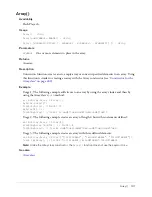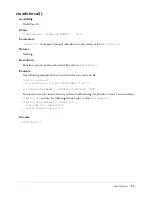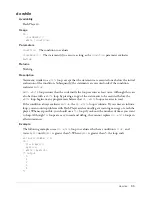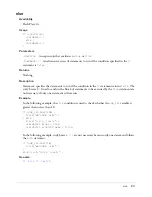
136
Chapter 5: ActionScript Core Language Elements
class
Availability
Flash Player 6.
Usage
[dynamic] class
className
[ extends
superClass
]
[ implements
interfaceName
[,
interfaceName
... ] ]
{
// class definition here
}
Parameters
className
The fully qualified name of the class.
superClass
The name of the class that
className
extends (inherits from). This parameter is
optional.
interfaceName
The name of the interface whose methods
className
must implement. This
parameter is optional.
Description
Statement; defines a custom class, which lets you instantiate objects that share methods and
properties that you define. For example, if you are developing an invoice-tracking system, you
could create an invoice class that defines all the methods and properties that each invoice should
have. You would then use the
new invoice()
command to create invoice objects.
The name of the class must match the name of the external file that contains the class. The name
of the external file must be the name of the class with the file extension .as appended. For
example, if you name a class Student, the file that defines the class must be named Student.as.
If a class is within a package, the class declaration must use the fully qualified class name of the
form base.sub1.sub2.MyClass (for more information, see
“Using packages” on page 57
). Also, the
class’s AS file must be stored within the path in a directory structure that reflects the package
structure, such as base/sub1/sub2/MyClass.as (for more information, see
“Understanding the
classpath” on page 64
). If a class definition is of the form “class MyClass,” it is in the default
package and the MyClass.as file should be in the top level of some directory in the path.
For this reason, it’s good practice to plan your directory structure before you begin creating
classes. Otherwise, if you decide to move class files after you create them, you have to modify the
class declaration statements to reflect their new location.
You cannot nest class definitions; that is, you cannot define additional classes within a
class definition.
To indicate that objects can add and access dynamic properties at runtime, precede the class
statement with the
dynamic
keyword. To declare that a class implements an interface, use the
implements
keyword. To create subclasses of a class, use the
extends
keyword. (A class can
extend only one class, but can implement several interfaces.) You can use
implements
and
extends
in a single statement. The following examples show typical uses of the
implements
and
extends
keywords:
CHAPTER 5
ActionScript Core Language Elements
Содержание FLEX-FLEX ACTIONSCRIPT LANGUAGE
Страница 1: ...Flex ActionScript Language Reference...
Страница 8: ......
Страница 66: ...66 Chapter 2 Creating Custom Classes with ActionScript 2 0...
Страница 76: ......
Страница 133: ...break 133 See also for for in do while while switch case continue throw try catch finally...
Страница 135: ...case 135 See also break default strict equality switch...
Страница 146: ...146 Chapter 5 ActionScript Core Language Elements See also break continue while...
Страница 229: ...while 229 i 3 The following result is written to the log file 0 3 6 9 12 15 18 See also do while continue for for in...
Страница 808: ...808 Chapter 7 ActionScript for Flash...
Страница 810: ...810 Appendix A Deprecated Flash 4 operators...
Страница 815: ...Other keys 815 Num Lock 144 186 187 _ 189 191 192 219 220 221 222 Key Key code...
Страница 816: ...816 Appendix B Keyboard Keys and Key Code Values...
Страница 822: ...822 Index...
















































